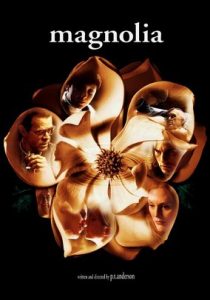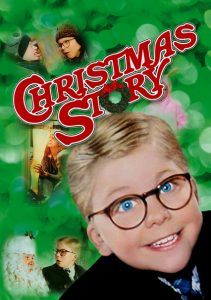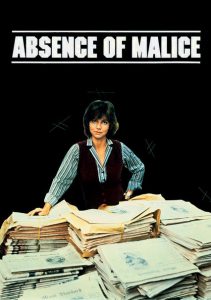Magnolia-1999
Director Paul Thomas Anderson
Starring Tom Cruise, Julianne Moore, John C. Reilly
Top 250 Films #67
Scott’s Review #777
Reviewed June 21, 2018
Grade: A
Paul Thomas Anderson is one of my favorite modern directors. In my opinion, his best film is Boogie Nights (1997), but he has also created other dark offerings, such as Phantom Thread (2017) and Inherent Vice (2014).
Arguably, his most distinctive effort might be Magnolia (1999), a cerebral film that explores themes of forgiveness and the meaning of life.
An ambitious effort, featuring a stellar ensemble cast, makes the film a fantastic experience.
Set in the San Fernando Valley (a mountainous area of Los Angeles), the film resembles David Lynch’s Mulholland Drive (2001) in area and oddness, along with unusual dialogue and offbeat characters.
A narrator explains three situations of extreme coincidence and surmises that chance may not be the only responsible party. Anderson then carves an intricate tale involving numerous characters, intersecting lives, and a riveting final climax during one rainy California day (an oddity in itself!).
The plot begins when we meet Jim Kurring (John C. Reilly), a police officer who is called to investigate a disturbance.
After finding a woman’s body in an apartment closet, events turn bizarre as a children’s game show host (Philip Baker Hall), his estranged daughter (Melora Walters), the show’s former producer, Earl (Jason Robards), who is dying from cancer, his drug-addicted wife Linda (Julianne Moore), Earl’s male caretaker (Philip Seymour Hoffman), a former game show champion (William H. Macy), and finally, an intense motivational speaker (Tom Cruise).
Quite a bevy of talented actors!
As the plot moves along mysteriously, the connections of each of the characters are not only revealed, but their peculiar motivations start to take shape.
For example, Linda, who married Earl for his money, seems to have an epiphany and demands her lawyer change Earl’s will. Later, a character may have a connection to Earl and Linda, but is it all as it seems?
In the case of Magnolia, the film is so wonderfully strange that it leaves the audience guessing throughout most of its running time.
Bizarre scenes are commonplace throughout the film. My favorite one is a marvelously creative scene. Suddenly, frogs begin to fall out of nowhere from the Los Angeles sky with numerous consequences for the characters.
The incident causes a ripple effect, of sorts, as many of the character’s fates are determined. Though one may not be able to make heads or tails of this scene or take complete logic from it, it’s enthralling all the same.
Magnolia has an overall quirky tone- sometimes upbeat-sometimes melancholy- that I adore. Films that are tough to figure out and that add an interesting musical score are so rich with flavor.
Aimee Mann is responsible for composing many of the songs on the musical soundtrack, so much so that she received a title credit on the soundtrack itself. Mann infuses richness into her music that is moody and diverse with ambient essentials.
Many actors make frequent appearances in Paul Thomas Anderson’s films. Magnolia alone seems almost like a Boogie Nights reunion with Moore, Walters, Macy, Baker Hall, and Philip Seymour-Hoffman to name just a handful.
The amazing aspect is that all of the aforementioned actors play vastly different, and arguably even more complex roles than they did in Boogie Nights.
Similar to Quentin Tarantino’s actors appearing in many of his films, what a creative treat this must be for them.
There is no doubt that Magnolia (1999) is a complex, dream-like, film. Open to interpretation and reflection, I find it to be a film that feels brilliant and that I would like to revisit and dive into even more and more with further viewings, for hopefully a better understanding and an even deeper appreciation.
Oscar Nominations: Best Supporting Actor-Tom Cruise, Best Screenplay Written Directly for the Screen, Best Original Song-“Save Me”


